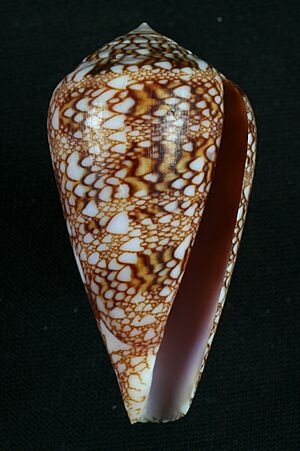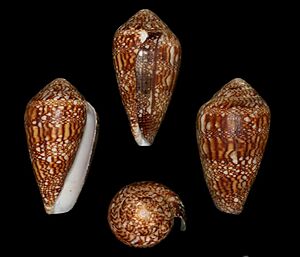Conus dalli facts for kids
Quick facts for kids Conus dalli |
|
|---|---|
 |
|
| Apertural view of shell of Conus dalli Stearns, 1873, measuring 53.3 mm in height, collected in the Bay of Chiriqui, Panama. | |
 |
|
| Conservation status | |
| Scientific classification | |
| Synonyms | |
|
The Dall's cone (scientific name: Conus dalli) is a type of sea snail. It's a marine gastropod, which means it's a snail that lives in the ocean. It belongs to the Conidae family, also known as the cone snails.
Like other cone snails, the Dall's cone is a predatory animal. This means it hunts and eats other small sea creatures. These snails are also venomous. They can "sting" humans, so it's very important to be careful. If you ever see a live one, it's best not to touch it at all.
What Does the Dall's Cone Look Like?
The shell of an adult Dall's cone can be between 32 mm and 80 mm long. That's about the size of a small candy bar or a little bigger.
The top part of the shell, called the spire, has faint grooves. The main part of the shell, the body whorl, has gentle spiral ridges near the bottom. The shell is usually yellowish-brown. It has reddish-brown stripes that run up and down. These stripes are broken up by four bands of white spots. Sometimes, there are also white spots on the darker parts of the shell. The inside of the shell's opening, called the aperture, is a pretty rosy pink color.
Where Do Dall's Cones Live?
You can find the Dall's cone in the eastern part of the Pacific Ocean. They live near the Galapagos Islands. They are also found from the Gulf of California all the way down to Panama. The first one ever officially described was found near the Islas Marias in the Golfo de California.
Gallery





